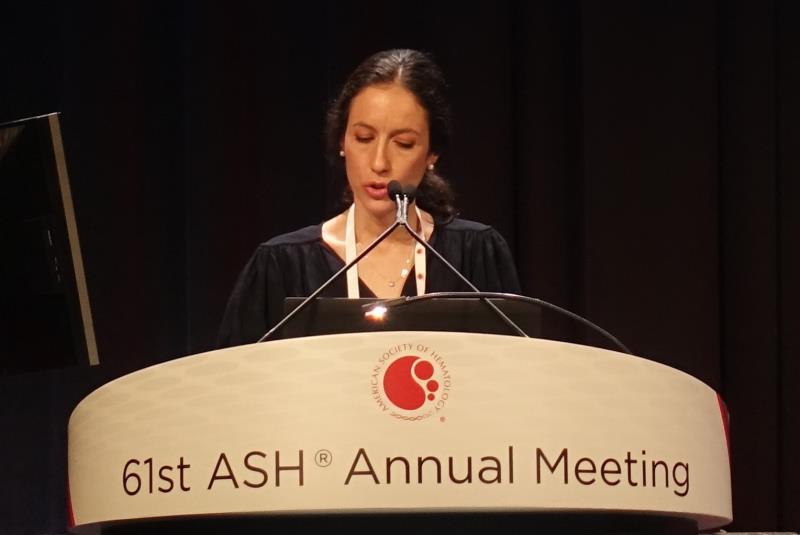 Dr Noemi Puig from the Hospital Universitario de Salamanca in Spain
Dr Noemi Puig from the Hospital Universitario de Salamanca in SpainIn the treatment of stem cell transplant-ineligible patients with newly diagnosed multiple myeloma (MM), the addition of clarithromycin (C) to lenalidomide (R) and dexamethasone (d) yields marked improvements in response rates that, however, do not equate to better survival, as shown in the results of the phase III GEM-Claridex trial.
The beneficial effect of C-Rd vs Rd alone on treatment response did not translate to increases in progression-free survival (PFS) and overall survival (OS) because of a significantly higher incidence of deaths, mostly due to infections, among elderly patients (age ≥75 years), according to lead investigator Dr Noemi Puig, from the Hospital Universitario de Salamanca in Spain, who presented the results at the 61st Annual Meeting of the American Society of Hematology (ASH 2019).
“Overexposure to steroids due to the delayed clearance induced by clarithromycin in this elderly population could explain our results,” Puig added.
The analysis included 288 newly diagnosed MM patients (median age, 76 years; 15.6 percent had high-risk cytogenetic abnormalities) who were ineligible for autologous stem cell transplantation (ASCT). These patients were randomly assigned to receive 28-day cycles of R (25 mg orally once daily on days 1–21) and d (40 mg orally [20 mg in patients aged >75 years] on days 1, 8, 15 and 22) alone (Rd arm, n=144) or in combination with C (500 mg orally twice daily; C-Rd, n=144) until disease progression or unacceptable toxicity.
Adding C to the standard Rd regimen produced significant improvements in treatment response. Specifically, patients in the C-Rd arm had deeper responses with a complete response (CR) rate of 20.1 percent and very good partial response (VGPR) rate of 52.8 percent as opposed to only 11 percent (p=0.037) and 37.1 percent (p=0.007), respectively, in the Rd arm.
Minimal residual disease (MRD) analysis at suspected CR and yearly afterwards showed that five patients in the C-Rd arm and nine in the Rd arm achieved undetectable MRD (3.5 percent vs 6.2 percent; p=0.7).
Primary endpoint not met
Over a median follow-up of 16 months, the primary endpoint of PFS did not significantly differ in the C-Rd and Rd arms (median, 23 months vs not reached, respectively; p=0.09).
Puig noted that while disease progression and/or death rate was comparable in the treatment arms (39.6 percent vs 31.2 percent, respectively), the addition of C to Rd led to a shorter PFS. This effect was especially pronounced in elderly patients (median PFS, 19 vs 28 months; p=0.03) but less so in younger patients (median PFS, 24 vs not reached; p=0.588).
“Concerning OS, no differences have been identified (p = 0.41), although median has not been reached yet in any arm,” she said.
Thirty-three and 28 deaths occurred in the C-Rd and Rd arms, respectively. The proportion of patients who died without documented progressive disease was notably higher in the former (82 percent vs 48 percent; p=0.004). Severe infections were the most frequent causes of death in C-Rd arm (14/27; 52 percent), with the majority of them having occurred in elderly patients (20/27; 74 percent).
Commonly reported grade 3–4 adverse events (AE) in the C-Rd and Rd arms were haematologic abnormalities, such as neutropenia (10.4 percent vs 16.7 percent, respectively; p=not significant) and anaemia (2.1 percent vs 6.9 percent; p=0.04). Grade 3–4 infections were the most frequent nonhaematological AE, occurring in 16 percent of patients in both arms. Only one patient in the C-Rd arm developed an invasive secondary primary malignancy, which was colon cancer.
“Continuous treatment with Rd is a standard of care for MM patients not candidates for ASCT. As previously reported, the addition of clarithromycin … has proven to be safe and effective, and case-control analyses suggested a significant additive value with the combination,” Puig said.
In light of the results of GEM-Claridex, Puig pointed out that clarithromycin may be added to Rd in newly diagnosed MM patients aged <75 years in consideration of administering dose reductions and prophylaxis for infections.